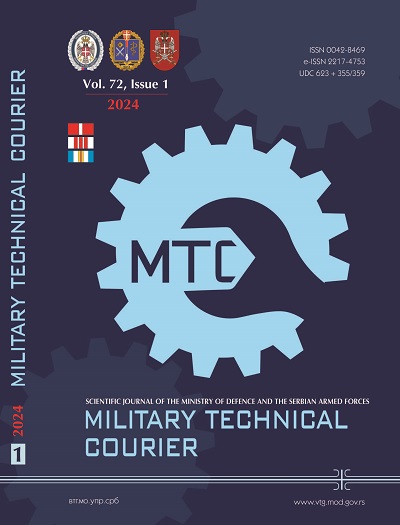Probabilistic multi-objective robust design and its application in metal cutting
Abstract
Introduction/purpose: Cutting is a typical material process. However, an appropriate solution for simultaneous optimization of material machinability and tool life in material cutting processes has not been obtained yet. In this article, probabilistic multi-objective robust design (PMORD) is expounded and the robust design problem in the simultaneous optimization of material machinability and tool life is analyzed by taking the machining of ferrite-bainite dual-phase steel as an example.
Methods: According to PMORD, the arithmetic mean and its deviation of various performance and utility indexes of alternative schemes are evaluated as twin independent responses, which respectively contribute a part of the partial preferable probability to the performance indexes. In the evaluation, the arithmetic average of the utility index is taken as the representative of the utility attribute, and the evaluation is made in accordance with the function or preference of the utility index. However, the deviation term is generally used as an unbeneficial type of the index (that is, the smaller the better) to participate in the evaluation. The product of the two parts of partial preferable probability is the actual partial preferable probability of the corresponding performance index. The product of the partial preferable probability of all performance utility indexes gives the total preferable probability of the corresponding scheme, which is the only index for each scheme to participate in the competition in robust design.
Results: The optimization result of this example is that the tool life is 1297.3333 s (standard deviation is 2.0817 s) and the surface roughness is 2.22μm (standard deviation is 0.2μm), while the corresponding working conditions are that the heat treatment temperature of the material is 790°C, the cutting speed is 150m/min, the feed speed is 0.15mm/rev, and the cutting depth is 0.2mm.
Conclusion: The example of the parameter optimization of cutting of ferrite-bainite dual-phase steel by means of PMORD indicates the rationality of the appropriate solution.
References
Box, G. 1988. Signal-to-Noise Ratios, Performance Criteria, and Transformations. Technometrics, 30(1), pp.1-17. Available at: https://doi.org/10.2307/1270311.
Box, G.E.P. & Meyer, R.D. 1986. Dispersion Effects from Fractional Designs. Technometrics, 28(1), pp.19-27. Available at: https://doi.org/10.1080/00401706.1986.10488094.
Hegde, A., Hindi, J., Gurumurthy, B.M., Sharma, S. & Ki, A. 2022. Machinability study and optimization of tool life and surface roughness of ferrite: Bainite dual phase steel. Journal of Applied Engineering Science, 20(2), pp.358-364. Available at: https://doi.org/10.5937/jaes0-32927.
Mori, T. & Tsai, S.-C. 2011. Taguchi Methods: Benefits, Impacts, Mathematics, Statistics, and Applications. New York, USA: ASME Press. Available at: https://doi.org/10.1115/1.859698.
Nair, V.N., Abraham, B., MacKay, J., Box, G., Kacker, R.N., Lorenzen, T.J., Lucas, J.M., Myers, R.H., Vining, G.G., Nelder, J.A., Phadke. M.S., Sacks, J., Welch, W.J., Shoemaker, A.C., Tsui, K.L., Taguchi, S. & Jeff Wu, C.F. 1992. Taguchi's Parameter Design: A Panel Discussion. Technometrics, 34(2), pp.127-161. Available at: https://doi.org/10.2307/1269231.
Roy, R.K. 2010. A Primer on the Taguchi Method, 2nd Edition. Michigan, USA: Society of Manufacturing Engineers. ISBN: 978-0872638648.
Welch, W.J., Buck, R.J., Sacks, J., Wynn, H.P., Mitchell, T.J. & Morris M.D. 1992. Screening, Predicting, and Computer Experiments. Technometrics, 34(1), pp.15-25. Available at: https://doi.org/10.2307/1269548.
Welch, W.J., Yu, T.-K., Kang, S.M. & Sacks, J. 1990. Computer Experiments for Quality Control by Parameter Design. Journal of Quality Technology, 22(1), pp.15-22. Available at: https://doi.org/10.1080/00224065.1990.11979201.
Zheng, M., Wang, Y. & Teng, H. 2022a. A novel method based on probability theory for simultaneous optimization of multi-object orthogonal test design in material engineering. Kovove Materialy/Metallic Materials, 60(1), pp.45-53. Available at: https://doi.org/10.31577/km.2022.1.45.
Zheng, M., Wang, Y. & Teng, H. 2022b. A novel approach based on probability theory for material selection. Materialwissenschaft und Werkstofftechnik/Materials Science & Engineering Technology, 53(6), pp.666-674. Available at: https://doi.org/10.1002/mawe.202100226.
Zheng, M., Teng, H., Yu, J., Cui, Y. & Wang, Y. 2023. Probability-Based Multi-objective Optimization for Material Selection. Singapore: Springer. Available at: https://doi.org/10.1007/978-981-19-3351-6.
Copyright (c) 2024 Jie Yu, Maosheng Zheng

This work is licensed under a Creative Commons Attribution 4.0 International License.
Proposed Creative Commons Copyright Notices
Proposed Policy for Military Technical Courier (Journals That Offer Open Access)
Authors who publish with this journal agree to the following terms:
Authors retain copyright and grant the journal right of first publication with the work simultaneously licensed under a Creative Commons Attribution License that allows others to share the work with an acknowledgement of the work's authorship and initial publication in this journal.
- Authors are able to enter into separate, additional contractual arrangements for the non-exclusive distribution of the journal's published version of the work (e.g., post it to an institutional repository or publish it in a book), with an acknowledgement of its initial publication in this journal.
- Authors are permitted and encouraged to post their work online (e.g., in institutional repositories or on their website) prior to and during the submission process, as it can lead to productive exchanges, as well as earlier and greater citation of published work (See The Effect of Open Access).

